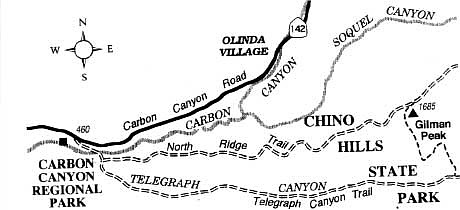 Facebook
Facebook
 X
X
 Instagram
Instagram
 TikTok
TikTok
 Youtube
Youtube
Gilman Peak's bald summit, barely poking over the lesser ridges of the Chino Hills of Orange and Riverside Counties, affords a breathtakingly spacious view of Southern California on a clear day. To the southwest lies the wide mouth of Santa Ana Canyon, scored by a broad flood channel carrying runoff that originates far inland amid the San Bernardino Mountains. Beyond, the vast urban plain of Orange County, resting on a vast sheet of alluvium, slopes gently toward the ocean. Northward, the gaunt San Gabriel Mountains, snow-capped in winter, rise boldly over foreground hills and valleys. In the southeast, the Santa Ana Mountains form a broad, dusky blister on the horizon.
A popular hiking or mountain-biking approach to Gilman Peak starts from the west, in or near Carbon Canyon Regional Park in the Orange County community of Brea. Many users of the Chino Hills trail system park their cars on the south shoulder of Highway 142 (Carbon Canyon Road), just east of the entrance to Carbon Canyon Regional Park, and start hiking or riding on a dirt road slanting southeast, just below the grade of the highway.
Following this route, you skirt a citrus orchard (one of the few remaining in Orange County) and soon reach a trail junction. Telegraph Canyon lies ahead; you veer left and start climbing on the North Ridge Trail, a dirt road. There are many native California walnut trees to be seen in the next couple of miles, their wispy branches swaying and their compound leaves shimmering in the breeze. These trees, which cling to north-facing slopes, offer welcome shade during the warmer months. They are deciduous, dropping their leaves by the late fall and regaining them in early spring.
By two miles into the hike or bike ride, the trail is staying high on the ridgeline, which is bald save for grass and low-growing sage-scrub vegetation. After you pass over a couple of smaller bumps on the ridge, Gilman Peak appears ahead, its summit accessible by way of a couple of narrow side trails.
You've come 3.5 miles so far. Return the same way -- or, if you are on foot you can follow a narrow trail descending into Telegraph Canyon, then head west through the canyon.


Gilman Peak's bald summit, barely poking over the lesser ridges of the Chino Hills of Orange and Riverside Counties, affords a breathtakingly spacious view of Southern California on a clear day. To the southwest lies the wide mouth of Santa Ana Canyon, scored by a broad flood channel carrying runoff that originates far inland amid the San Bernardino Mountains. Beyond, the vast urban plain of Orange County, resting on a vast sheet of alluvium, slopes gently toward the ocean. Northward, the gaunt San Gabriel Mountains, snow-capped in winter, rise boldly over foreground hills and valleys. In the southeast, the Santa Ana Mountains form a broad, dusky blister on the horizon.
A popular hiking or mountain-biking approach to Gilman Peak starts from the west, in or near Carbon Canyon Regional Park in the Orange County community of Brea. Many users of the Chino Hills trail system park their cars on the south shoulder of Highway 142 (Carbon Canyon Road), just east of the entrance to Carbon Canyon Regional Park, and start hiking or riding on a dirt road slanting southeast, just below the grade of the highway.
Following this route, you skirt a citrus orchard (one of the few remaining in Orange County) and soon reach a trail junction. Telegraph Canyon lies ahead; you veer left and start climbing on the North Ridge Trail, a dirt road. There are many native California walnut trees to be seen in the next couple of miles, their wispy branches swaying and their compound leaves shimmering in the breeze. These trees, which cling to north-facing slopes, offer welcome shade during the warmer months. They are deciduous, dropping their leaves by the late fall and regaining them in early spring.
By two miles into the hike or bike ride, the trail is staying high on the ridgeline, which is bald save for grass and low-growing sage-scrub vegetation. After you pass over a couple of smaller bumps on the ridge, Gilman Peak appears ahead, its summit accessible by way of a couple of narrow side trails.
You've come 3.5 miles so far. Return the same way -- or, if you are on foot you can follow a narrow trail descending into Telegraph Canyon, then head west through the canyon.
